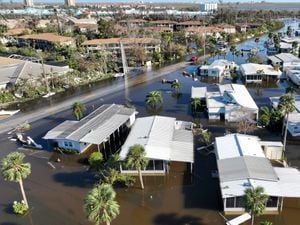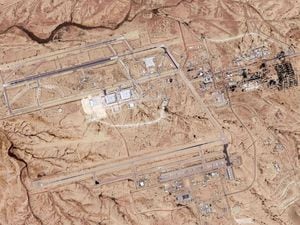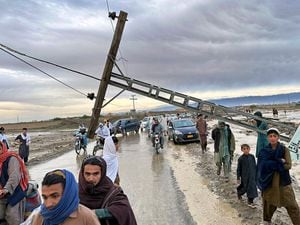Hurricane Ian heads for Carolinas after pounding Florida
The megastorm has left people trapped inside their homes in Florida.

A revived Hurricane Ian is threatening coastal South Carolina and the historic city of Charleston with severe flooding after the deadly storm caused catastrophic damage in Florida and trapped thousands in their homes.
With South Carolina’s coast under a hurricane warning, sheets of rain whipped trees and power lines, and many areas on Charleston’s central peninsula were already under water by noon. Streets in the 350-year-old city were largely empty.
Ian’s anticipated landfall just up the South Carolina coast is expected to coincide with high tide, which would make flooding worse.
The hurricane left a trail of destruction after it came ashore on Wednesday on Florida’s Gulf Coast as one of the strongest storms ever to hit the US.
The storm flooded areas on both of Florida’s coasts, tore homes from their foundations, demolished beachfront businesses and left more than two million people without power.
At least seven people were confirmed dead in the state — a number that looks likely to increase as officials confirm more deaths and continue searching for people.
In Charleston on Friday, powerful wind gusts bent tree branches and sent sprays of steadily falling rain sideways. Streets in the 350-year-old city were largely empty.
With winds holding at 85mph, the National Hurricane Centre’s latest update placed Ian about 60 miles south east of Charleston and forecast a “life-threatening storm surge” and hurricane conditions along the Carolina coastal area.

The hurricane warning stretched from the Savannah River to Cape Fear, with flooding likely across the Carolinas and south-western Virginia, the centre said.
The forecast predicted a storm surge of up to 7ft into coastal areas of the Carolinas, and rainfall of up to 8in.
In Florida, rescue crews piloted boats and waded through flooded streets on Thursday to save thousands of people trapped in homes and buildings shattered by Hurricane Ian.
Florida governor Ron DeSantis said rescue crews have gone door-to-door to more than 3,000 homes in the hardest-hit areas.
“There’s really been a Herculean effort,” he said on Friday during a news conference in Tallahassee.
Climate change added at least 10% more rain to Hurricane Ian, according to a study prepared immediately after the storm, said its co-author, Lawrence Berkeley National Lab climate scientist Michael Wehner.
Those killed in Florida included a 67-year-old man who was waiting to be rescued and fell into rising water inside his New Smyrna Beach home late on Thursday, Volusia County Sheriff’s Office said. Patrol vehicles had been unable to reach him because roads were flooded.
At least three people were reported killed in Cuba after the hurricane struck there on Tuesday.

One of the worst hit areas was Fort Myers on the Gulf Coast, where businesses near the beach were completely razed, leaving twisted debris.
Broken docks floated at odd angles beside damaged boats, and fires smouldered on lots where houses once stood.
The road into Fort Myers was littered with broken trees, boat trailers and other debris. Cars were abandoned in the road, having stalled when the storm surge flooded their engines.
Emergency crews sawed through toppled trees to reach stranded people. Many in the hardest-hit areas were unable to call for help because of electrical and mobile outages.

A chunk of the Sanibel Causeway fell into the sea, cutting off access to the barrier island where 6,300 people live.
Hours after weakening to a tropical storm while crossing the Florida peninsula, Ian regained strength on Thursday evening over the Atlantic.
The National Hurricane Centre predicted it would hit South Carolina as a Category 1 hurricane on Friday, still much weaker than the Category 4 hurricane it was on Wednesday.
National Guard troops were being positioned in South Carolina to help with the aftermath, including any water rescues.
In Washington, President Joe Biden approved an emergency declaration for the state, a needed step to speed federal assist for recovery once Ian passes.
The storm is on track to later hit North Carolina, forecasters said. Governor Roy Cooper urged residents to prepare for torrents of rain, high winds and potential power outages.





